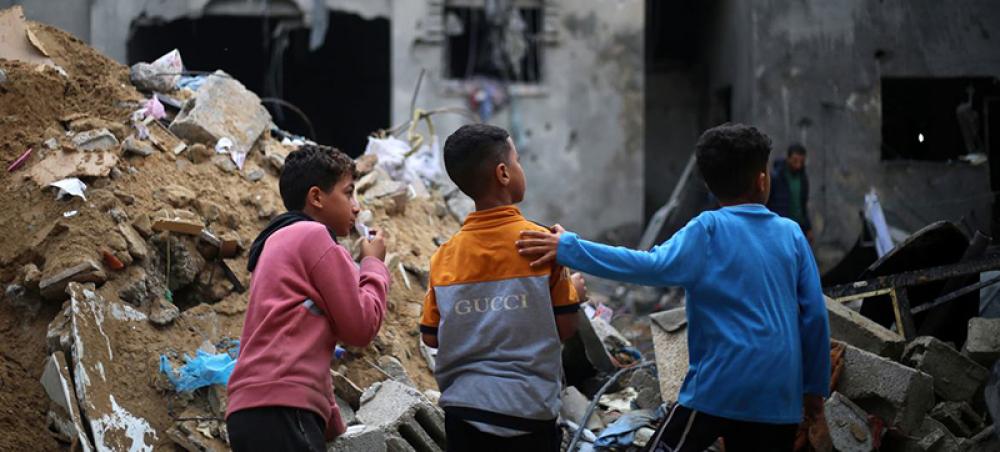Just Earth News | @justearthnews | 20 Dec 2023

Photo Courtesy:UNICEF/Eyad El Baba
Gaza is by far the most dangerous place in the world to be a child and deaths of youngsters from disease will likely surpass those from bombardment in the absence of a ceasefire, the UN Children’s Fund (UNICEF) warned on Tuesday.
A lack of food, water, shelter and sanitation continues to put children’s lives at risk as they suffer under relentless airstrikes with no safe place to go, said UNICEF spokesperson James Elder, who recently returned from the enclave.
Ahead of a UN Security Council meeting expected to call for a pause in fighting to facilitate aid access, he told journalists in Geneva that “every single child is enduring these 10 weeks of hell and not one of them can escape”.
“As a parent of a critically sick child told me, ‘Our situation is pure misery…I don’t know if we will make it through this,’” he said.
According to the Gaza health authorities, over 19,400 Palestinians have been killed in the enclave since the start of Israel’s retaliation for Hamas’ deadly terror attacks on 7 October, about 70 per cent of them women and children.
Over 52,000 Palestinians have been injured and their access to life-saving care is extremely limited. UN health agency WHO said on Tuesday that only eight of the 36 hospitals in the Strip are at least partially functional.
‘Beyond belief’
Hospitals are overwhelmed with children and their parents, all bearing “the ghastly wounds of war”, Mr. Elder said. He stressed that while in the Strip he encountered many young amputees. Around 1,000 children in Gaza have lost one or both their legs, he said.
From the UN World Health Organization (WHO), spokesperson Dr. Margaret Harris added that WHO staff in Gaza spoke of not even being able to walk in the emergency wards “for fear of stepping on people” lying on the floor “in severe pain” and asking for food and water.
She called the situation “unconscionable” and said that it is “beyond belief that the world is allowing this to continue”.
Hospital shelled
Over the past 48 hours, the largest remaining hospital in Gaza, Al Nasser Hospital in Khan Younis in the south, was shelled twice, Mr. Elder said.
That hospital “not only shelters large numbers of children who had already been badly injured in attacks on their homes, but hundreds of women and children seeking safety”, he stressed, referring to those who’ve had to flee because of the hostilities and evacuation orders.
Some 1.9 million people, or the vast majority of the enclave’s population, are estimated to be displaced in Gaza.
Injured children dealing with the loss of loved ones have been forced to move again and again, Mr. Elder said. “Where do children and their families go? They are not safe in hospitals. They are not safe in shelters. And they are certainly not safe in the so-called ‘safe’ zones,” he insisted.
No place is safe
The UNICEF spokesperson explained that the “safe zones” were “anything but safe” because they had been designated unilaterally by Israel alone and lacked “sufficient resources for survival”: food, water, medicine, protection.
Mr. Elder described these zones as “tiny patches of barren land, or street corners, or half-built buildings, with no water, no facilities, no shelter from the cold and the rain and no sanitation”.
“Under the current besieged conditions, adequate supplies for such zones are impossible,” he said, adding that during his recent stay in Gaza he had experienced this reality first-hand.
Diarrhoea and malnutrition
The UNICEF spokesperson highlighted the dire lack of adequate sanitation, pointing out that in Gaza there is one toilet for 700 people on average. Diarrhoea cases in children are above 100,000 and combined with soaring malnutrition can prove increasingly deadly, he said.
Mr. Elder added that more than 130,000 of children under two are not receiving “critical life-saving breastfeeding and age-appropriate complementary feeding” such as micronutrient supplementation.
Ceasefire ‘the only way’
The delivery of aid is a “matter of life or death” for children in Gaza, Mr. Elder said, and the conditions to provide that aid “are not being met”.
The number of aid trucks allowed into Gaza remains “well below the daily average of 500 truckloads” that entered every working day prior to 7 October, according to the UN humanitarian affairs coordination office, OCHA.
On Sunday, OCHA said that 102 trucks carrying humanitarian supplies and four tankers of fuel entered Gaza through the Rafah crossing from Egypt and 79 trucks entered through the Kerem Shalom crossing from Israel, for the first time since the start of the escalation.
WHO’s Dr. Harris stressed that beyond bringing in supplies across the border into the enclave, it was a challenge to get aid to where it’s needed, because of the ongoing hostilities but also the massive damage to roads.
“An immediate and long-lasting humanitarian ceasefire is the only way to end the killing and injuring of children, and child deaths from disease, and enable the urgent delivery of desperately needed life-saving aid,” Elder said.